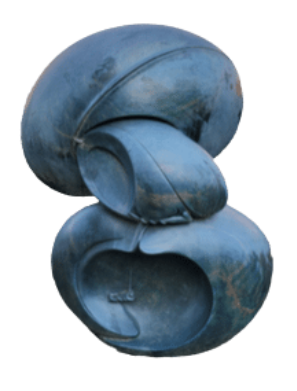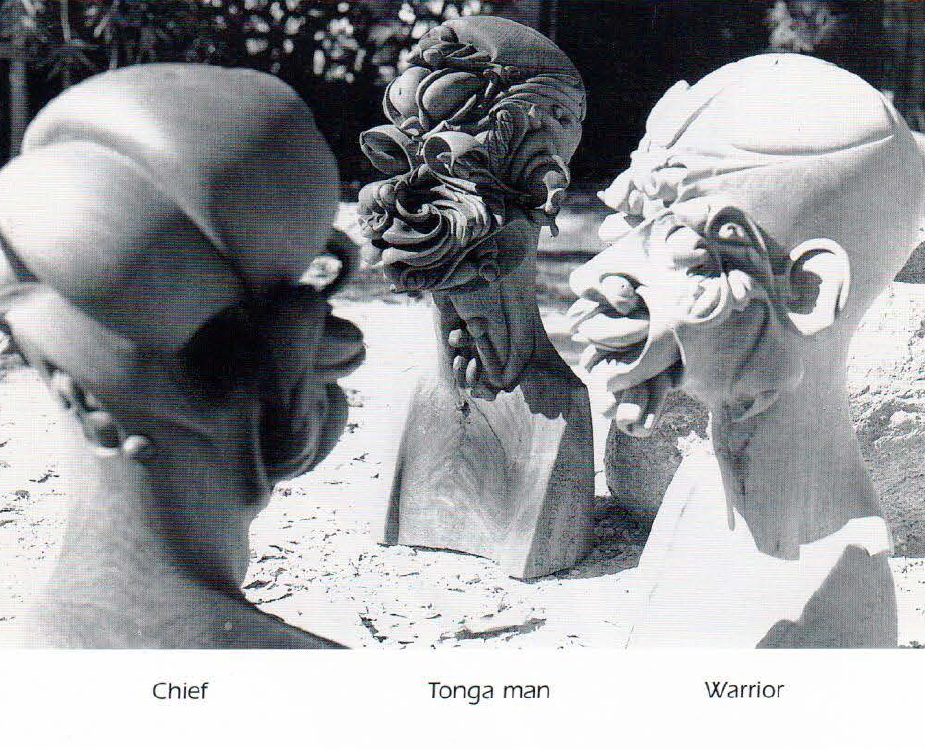Sampson Kuvenguhwa - Artist name Sam Kuve - Shona Sculptor
Sam was born in Zimbabwe on 5th March 1953. He was educated at Chiunyes in Mudzi district. He has been sculpting more or less continuously for the past 19 years and has had great success in Zimbabwe with his various pieces. Many of the pieces shown here were already on display at the Harare National Art Gallery. In the early 1990's, a Vernisage was organised in a village in Switzerland where Sam was able to present his art and his thoughts. It was at this time that Sam told us his life story and the making of Mapiti art style a real story of shona sculpturing and art.

Following is a resume of Sam’s life as told by himself:
"My fore-fathers are of the Soko Vashawasha Clan who lived in the Mabvuku and Msasa Areas. 1 was born into a family of five and 1 was christened 'Samson·.
I got my name because my mother who had had two babies who had died, decided to go to church. She went to the Apostolic Church where a man was possessed with the Holy Spirit, and she was told she was to have a baby boy and that she should name him Samson. So, on Friday night at 10:00 pm 5th March 1953 I was born.
My father’s name was Kufaidzungu Kuvenguhwa, and he was, as was his father, a polygamist. My grandfather could do this because he was wealthy. He worked as a blacksmith, did some crafting and finally he became a well-known hairdresser. So, by having many wives, he in turn had many children, and so my father was among these children.
When he grew up, he inherited some of his father’s wealth, which included property. After inheriting the wealth, he in turn worked very hard to maintain and improve his status until he was also a very rich man. This enabled him to have more wives, after my mother who was the first. At the end he had three wives and twenty-one children.
As I grew up, I lived with my grandmother whose name was Kuona. My grandmother survived on art, and she also did some pottery using clay. She could make pots and whenever she did this, I was always close by watching her and this finally interested me, and I started doing my own thing.
As the years went by, I finally made it so that even the elders could not match up with me including the village girls who were much older than me.
I did this pottery until the year 1961 when I was eight years. That is when I started to go to school. My school days were not that
good because I was not good in the lessons with the exception of art. My teachers recognized that I had the potential of doing some good work and that is how my talent became known. During the art lessons which were held in the afternoon I proved a promising artist. We did basket making, pottery, painting on newsprint and on manila paper and finally some carpentry.
At the age of fourteen I started a basic course in art sculpture. I carved a wooden lorry which attracted a policeman called Mujoni. This lorry could carry three persons in the front and two at the back. The policeman was so attracted to the lorry that he persuaded me to sell it to him. In the First instance I refused, but when he offered me a pair of shorts and a shirt and some money, I had to give him the lorry.
As I was young, most of my time was spent at school and because the family continued to grow, I could not get the money to go to school and so I had to make things that I could sell. I started ma king hats out of Llala (reeds). Unfortunately, I had to leave school after grade five as my father was unable to afford the school fees. I had to now make ends meet, so I thought of alternative ways to make ends meet.
I decided to find a job The First job was as a house worker/gardener on a farm, which I kept until 1969 and then decided to move into the city where there were better prospects. Here I was offered a job in Mabelreign (Harare) in the garden and earned $ 2.50 per month. In 1970 I got a job with a Greek restaurant as a cook and was paid $ 12 per month. 1 worked there as a cook for four years and then left to work for N.V.M. sweets and became a traveling salesman. I worked in several other jobs until, in 1977, after exploring Salisbury (Harare) I came across a place where there was some carving.
As I was interested in art I soon headed towards that place, Canon Patterson Craft Centre in Mbare (formally Harare). To myself this proved to me that I was an artist as no matter what I carved people admired it. As I was not used to mixing with so many people, I then left for Kambuzuma where I went to the nearby Westwood Hill and started carving for myself.
While on the way, I met two brothers who usually carved on the Bulawayo Road, and I asked them if I could carve with them. They agreed and we stayed together until we were given a place at Westwood Hill where we could carve our pieces, display them and sell them along the Bulawayo Road.
Even though I was now becoming renowned for my artistic work, I still knew that I was in the learning process but with no teacher. I was rather my own teacher.
As I was not used to staying with many people, I again decided to leave Westwood Hill nd move along. Later that year. 1980, I became extremely sick. I was somehow possessed by the ancestral spirit, Mudzimu, but this was rather unusual as my parents were Christians.
This was a tormenting experience for me and my parents didn't know how to solve the problem. When I finally decided to leave Harare, I went back to my roots, Mutoko. There I started living in the thick jungles of an area called Ma piti. I took my family with me. Here I carved inwood. My hair had grown into dreadlocks. My two children and my wife still lived with me. My mother was worried the most all this time and was trying to find a solution to my problems. Since she tried to solve my problems in a traditional way, she lost her membership in the church.
Eventually she went to a N'Anga (African Doctor) who advised her to brew some African Beer and dance for three days and nights. She did all this in the jungle where I was staying. During this time I had not changed my life style but my food and facial appearance had changed. 1 was now eating groundnuts, sorghum, peanuts, and maize. 1981 passed and still the problem was with me but still I did not forget my art lessons.
I carved my pieces while in the bush including heads which I named Matonga Smiling Faces. Now this was the new look Mapiti Style which I am specializing in now.

I then left Mtoko and came to Warren Park where I eventually completed my course in art and now I have my own style, the Mapiti Style.
In the long run I hope to establish the type of music which reflects my artistic work and I hope many people will come to understand my type of art."


An interesting Video of Sam at home uploaded by Zimsculpt onto You Tube
The text as shown in the Video:
Stone draped folded representing ancient statuary stone, gnarled and knotted, so that sculpture resembles trees, dried by the African sund, stone straight from the quarry with a smooth touch, such are the sculptures of Samson Kuvenguhwa. Kuvenguhwa crosses sculptures boundaries as defined by culture and its various traditions, yet his work affords these traditions, their congress. His carving spans the traditional and the contemporary. HIs stone has the apperance of ancientt clay well fired hot from the kiln. Kuvenguhwa draws upon his heritage, and he is skilled interpreter of his own history. To Kuvenguhwa sculptures is music wtih a different sound dance with a different rhythm, mask covering different faces. He is not an artist who sells through his name, but a name which sells through his art.
Click here for the shona sculptures and other information on Sam